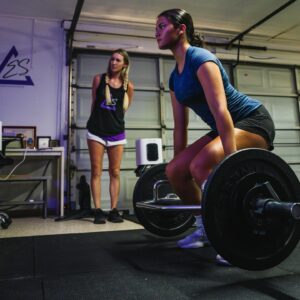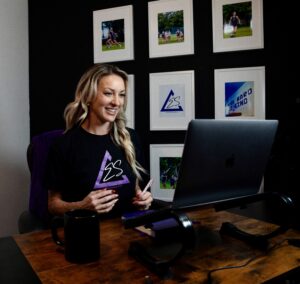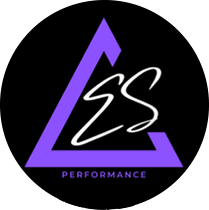
11 Jul Random Workouts and Circuits DO NOT Work for Female Athletes: True Speed, Agility and Strength Training
Female athletes, I have a question.
Are you doing intentional work, or busy work?
Seriously ask yourself this question. It’s something you need to get clear on to move to the next level and to reach your performance goals.
Too often, many of you think working out is enough.
You know, looking like you’re doing something, without getting anywhere at all. You know, looking busy with tons of training sessions and doing random workouts that you found on TikTok. You know, performing a circus of exercises with no real goal in mind. You know, bouncing from a ladder drill, then to a push up, then to a deadlift, then to a hurdle hop with no properly designed rest times or load progressions.
I hate to say it, but I have news for you: this is busy work. Not intentional work. It’s random, not purposeful. It’s chaotic, not progressive. There’s no specific adaptation in mind except to look busy and break a sweat.
Stop Throwing Together Random Workouts
Anyone can throw together a series of random workouts they found online, but are these actually getting you the desired adaptation?
If speed is your goal, for example, are you training explosive outputs of less than 6 seconds or less, or are you tapping your feet for minutes on end? If it’s the latter (no pun intended), then you’re simply making your feet sore and just getting your heart rate up. Nothing more.
If strength is your goal, does it make sense to do a circuit with light weights with hardly any rest in between sets? Building strength requires longer rest times so you can lift heavier weights and progress. Being able to deadlift your bodyweight and beyond requires rest times from 3-5 minutes in between sets. Otherwise, technique will break down.
If in-season maintenance and match readiness/recovery are your goals, it’s not in your best interest to a deadlift for 4 sets of 10. High set and high rep are the enemy in-season because it causes muscle soreness. In-season big lifts should be 8 reps or less.

If agility is your goal, please stop throwing together a jumble of hurdle jumps, ladders, and feet tapping drills. First, these don’t train agility. Second, when your workout is this messy and random, you end up chasing multiple rabbits and catching none.
Look. I’m on social media and I share a lot of the workouts I do with my girls. However, my posts are not prescriptive. By no means am I insinuating you do these on your own. They’re just ideas for you to get curious about proper training and get you excited about working with a strength coach!
The truth is, you shouldn’t take workouts you see on social media and make your own, random program. Proper strength and conditioning programming is an art, and it requires meticulous attention to detail.
Proper programming, done by a professional strength and conditioning coach, takes appropriate:
– Dosing: how many sets and reps needed to achieve the right muscular adaptation? Strength = less than 6 reps. Muscular endurance = 15 reps.
– Intensity: what intensity are you lifting at? To build strength, are you eventually lifting weights that are 8/10 or 9/10 intensity?
– Timing: when are you doing your workouts? If your goal is speed, are you doing your speed workouts BEFORE practice when your nervous system is fresh? And on the macro level, are you in season or off season? Does this point in the season require less volume or more?
– Exercise Selection: are you doing the appropriate exercise based on your ability? If you’re new to strength training, are you starting with a goblet squat rather than a heavy back qquat? Or if you’re a veteran, are you now doing single leg, lateral plyometrics rather than snap downs?
– Progression: are you progressing your program? Are you changing volume and intensity to become stronger, more conditioned, and more explosive? Are you not hanging out at the same weights all the time, but upping 5-10lbs each week?
And all of the above are also influenced by:
– Age of the athlete
– Maturation status (biological age)
– Readiness
– Exercises History
– Injury History
– Long Term Goals
I understand all of the above for new athletes who come to my gym in Tampa Florida, so I can best write their custom training program. It will look different for everyone – no cookie cutter programming!
It is very dangerous to take everything you see on social media as something you should do. Strength and conditioning programs should be written by a professional who understands dosing, timing, exercise selection, and progression. The professional must assess your athlete first, too, to see where their starting point will be in a strength program.

Female athletes cannot gain insane strength unless they are progressing overtime, and are under the supervision of a professional. Pulling heavy loads isn’t easy, so there must be attention to detail with the set/rep schemes each week, proper technique instruction, and the proper building up of intensity.
I now have girls front squatting 50% of their body weight because we progressed each week. First, we upped volume, then we upped the load lifted. The girls were consistent and focused. They were intentional.

It’s frustrating that not everyone understands this. These are basic principles of training and muscle adaptation.
The other day, I saw on Facebook a group of three female athletes doing a three-circuit workout. The first station was a ladder. The second station was a dumbbell deadlift. The third station was a push-up. And on they went through the circuit with no goal in mind. The only thing it did was I guess get them moving. But it was busy work, not intentional work.
There was no strength focus because the weight wasn’t heavy or progressed. And it was the same for all girls. What if one girl could lift more than the others?
Too, there was no correcting of push-up form. I’m a stickler for push-up form and my goodness are many girls butchering push-ups. No core strength due to drooping hips not lined up with the shoulders. As soon as my girls’ hips droop, I call them out and have them redo the set with glutes engaged and ensuring they’re keeping tension.
And then the ladder drill? Ya’ll know how I feel about ladders. They slow athletes down and build only slow twitch muscles. For speed, athletes must sprint as fast as possible, race, and/or be timed.

There was no intention behind the workout circuit I saw on Facebook. Most circuits are busy work to make it look like these girls were getting somewhere, but they weren’t getting anywhere at all. No strength, no speed, no agility development was happening.
And this isn’t a phenomenon I’m seeing only on social. I see it at youth soccer clubs where the club-wide fitness coach will program what I call “white board” workouts where it will be a random circuit for the day. There’s no customization, no progression of lifting heavier loads, just the same weights each week, and only girls plateauing. White board workouts are lazy and they’re doing our female athletes a disservice because none of them are actually getting stronger.
So I implore you, ask yourselves, are your workouts designed intentionally? Are you selecting exercises, putting together proper set/rep schemes and rest times for the goals you want to achieve? What muscular adaptation do you want?
You decide.
Do intentional work, not busy work.
ABOUT THE AUTHOR

Erica Mulholland is a former college 3x All-American soccer player and now Hall of Famer from Johns Hopkins University. She holds a Master of Science in Exercise Science and has been helping female athletes of all sports with speed, agility, strength, power, and conditioning for over 13 years. She has worked with soccer, lacrosse, track, volleyball, softball, and basketball girls, and has inspired her athletes to strength train not just for sport, but for life. She does speed, agility, and strength training in the Tampa area in Lutz and Land O Lakes Florida as well as remotely worldwide: BOOK YOUR ASSESSMENT HERE
Need more personalized help from Erica? BOOK A CONSULT HERE

Interested in Remote Training for Female Athletes? BOOK A CONSULT HERE
Get Erica’s first book THE STRONG FEMALE ATHLETE
Get Erica’s second book FEMALE ATHLETE HIGH PERFORMANCE

Check out her podcast: The Strong Female Athlete


No Comments